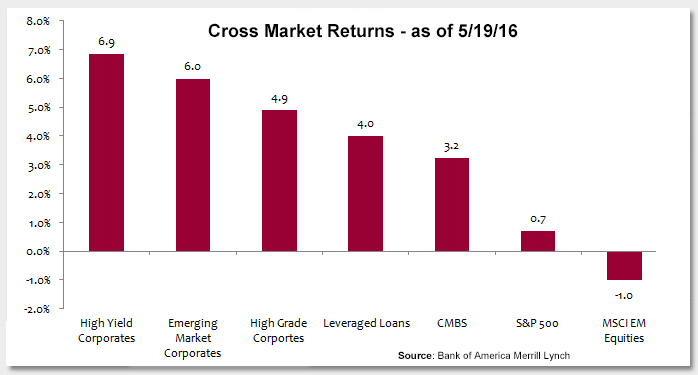The high yield market has staged a remarkable comeback from its January and early February swoon and is now tracking for its best year since 2012. Total returns for the asset class through the third week of May are close to 7%, outpacing all other risk markets by a wide margin. This week’s chart shows the relative total return performance of the S&P 500 Index, leveraged loans, emerging market credit, commercial mortgage-backed securities (CMBS), and other fixed income asset classes as of May 19. The excess returns of high yield, which is the return for fixed income assets excluding the Treasury component, is even more pronounced compared to other markets as high yield credit spreads have rallied almost 100 basis points. The rebound in oil prices has played a prominent role in the strong performance as energy credit represents over 15% of the high yield index and also serves as a proxy for global growth. The virtuous circle of dovish central bank actions, a weaker dollar, high oil prices, lower treasury rates, and reasonable macro data have reduced tail risk and reinstituted the reach for yield in the market. The question is: what is the durability of the rally and what could derail it?
Despite the wild market swings in prices this year, the corporate fundamentals story remains largely the same as it has been over the last few years – weak revenue and earnings offset by strong margins and free cash flow. An important milestone occurred in mid May with the $20 billion financing for the Dell/EMC leveraged buy-out. While this was the low investment-grade tranche, it was an important clearing event for the entire corporate market. At the same time, Petrobras, the scandal- and debt-laden Brazilian oil giant, regained access to the market as it was able to price a $6.75 billion dollar-denominated deal. Market access is currently wide open and new issuance is rapidly accelerating after getting off to a very slow start in 2016.
Key Takeaway:Risk markets tend to be correlated, implying the wide outperformance of the high yield assets relative to other risk markets will not be sustained indefinitely. Given what I view as full valuations, absolute yields and the current surge in new issuance, my bias is to position for a pullback in spreads as volatility will likely reemerge.
The material provided here is for informational use only. The views expressed are those of the author, and do not necessarily reflect the views of Penn Mutual Asset Management.
This material is for informational use only. The views expressed are those of the author, and do not necessarily reflect the views of Penn Mutual Asset Management. This material is not intended to be relied upon as a forecast, research or investment advice, and it is not a recommendation, offer or solicitation to buy or sell any securities or to adopt any investment strategy.
Opinions and statements of financial market trends that are based on current market conditions constitute judgment of the author and are subject to change without notice. The information and opinions contained in this material are derived from sources deemed to be reliable but should not be assumed to be accurate or complete. Statements that reflect projections or expectations of future financial or economic performance of the markets may be considered forward-looking statements. Actual results may differ significantly. Any forecasts contained in this material are based on various estimates and assumptions, and there can be no assurance that such estimates or assumptions will prove accurate.
Investing involves risk, including possible loss of principal. Past performance is no guarantee of future results. All information referenced in preparation of this material has been obtained from sources believed to be reliable, but accuracy and completeness are not guaranteed. There is no representation or warranty as to the accuracy of the information and Penn Mutual Asset Management shall have no liability for decisions based upon such information.
High-Yield bonds are subject to greater fluctuations in value and risk of loss of income and principal. Investing in higher yielding, lower rated corporate bonds have a greater risk of price fluctuations and loss of principal and income than U.S. Treasury bonds and bills. Government securities offer a higher degree of safety and are guaranteed as to the timely payment of principal and interest if held to maturity.
All trademarks are the property of their respective owners. This material may not be reproduced in whole or in part in any form, or referred to in any other publication, without express written permission.


